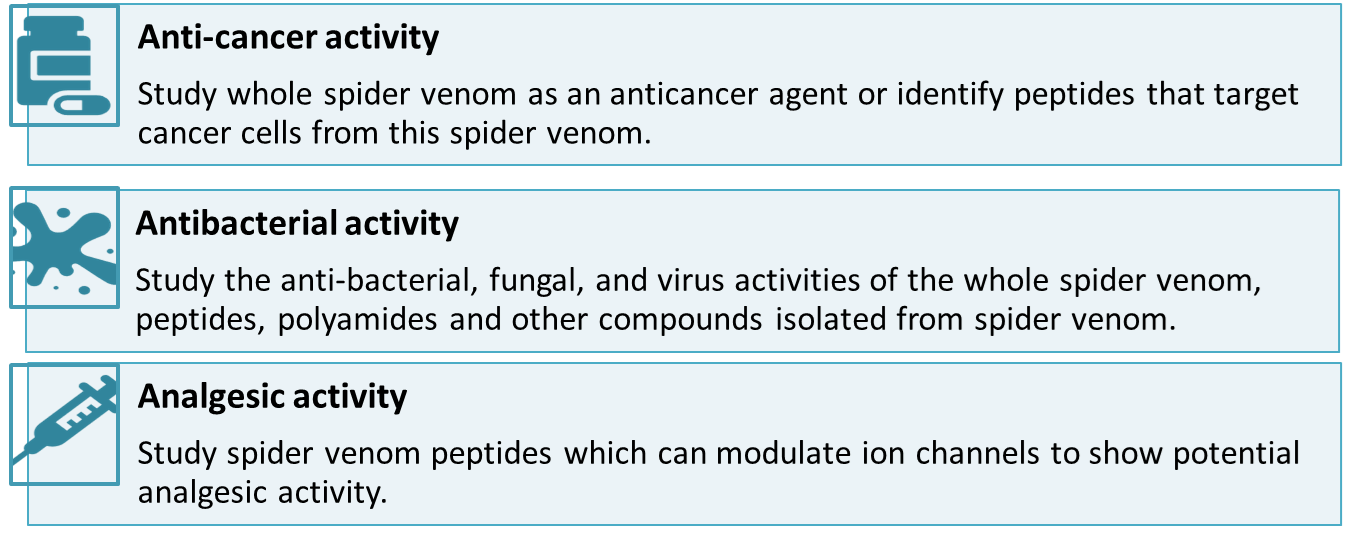Spider Venom Solutions
As a professional venomomics service provider, Creative Proteomics has rich service experience and professional service level, provides complete solutions for spider venom research to help customers explore spider venom systems, analyze spider venom components, their biochemical properties and pharmacological activities.
Introduction
Spiders are a variety of predatory arthropods, and they are known for their complex venom systems used to suppress their prey. Spiders produce their venom components in the special secreting cells of the venom glands, which are surrounded by the muscle layer, and control the release of venom by squeezing the venom glands. Spider venom is a mixture of many chemical substances, containing many highly specific and effective proteins and peptides, suitable for biomedical or agrochemical applications. The spider venom of a specific species is a mixture containing more than one hundred components that act on different targets, including various receptors, mainly located in the muscle or nervous system, cell membranes and extracellular matrix. Although a single component may be toxic, it is the synergy between these components that can exert the full toxicity of the venom.
Spider Venom Solutions
We are committed to advancing the development of spider venom research, focusing on providing diverse analysis techniques to study the structure and function of spider venom components. Specific spider venom solutions include:
- Analysis of Spider Venom Components. Spider venom is a very complex mixture composed of thousands of different components, which are divided into the following four main categories to explore: small molecules, larger proteins, cysteine-rich peptides, and antimicrobial peptides.
| Categories |
Description |
Technical methods |
| Small molecules |
Including ions, organic acids, nucleotides, nucleosides, amino acids, amines and polyamines. |
Sequencing, BLAST, HPLC, MS, etc. |
| Larger proteins |
It is a key component of spider venom, including hyaluronidase, collagenase, phospholipase, etc. |
| Cysteine-rich peptides |
It is a functionally important component, which is explored from several aspects such as structural patterns, target points, and interactions. |
| Antimicrobial peptides |
It has a high positive net charge and a large amount of hydrophobic amino acids, which destroys the integrity of the cell membrane. |
- Analysis of pharmacological characteristics of spider venom. Perform venom toxicity, lethality determination and morphological analysis.
- Analysis of the therapeutic activity of spider venom. Many spider venom components show potential therapeutic activity against a wide range of human diseases. Creative Proteomics helps you explore the activity and possible mechanism of spider venom and its components in the therapeutic field.

Advantages
- One-stop solutions. From the separation and detection of venoms to advanced analysis and active molecular screening, all are included in our services.
- Personalized solutions. The choice to meet your unique venom research requirements, not limited to the research of common toxic species.
- Professional solutions. Bring our accumulated knowledge and experience, characteristic technology and platform into our solutions.
Creative Proteomics is a biotechnology company with high comprehensive quality in terms of expert team, customer service, solution supply, and practical application. We are committed to becoming your reliable professional partner in venomomics research and providing you with first-class service. Learn more about spider venom solutions, please contact us for help.
Reference
- Langenegger N. et al. Spider Venom: Components, Modes of Action, and Novel Strategies in Transcriptomic and Proteomic Analyses. Toxins, 2019, 11(10):611.
For research use only. Not intended for any clinical use.

